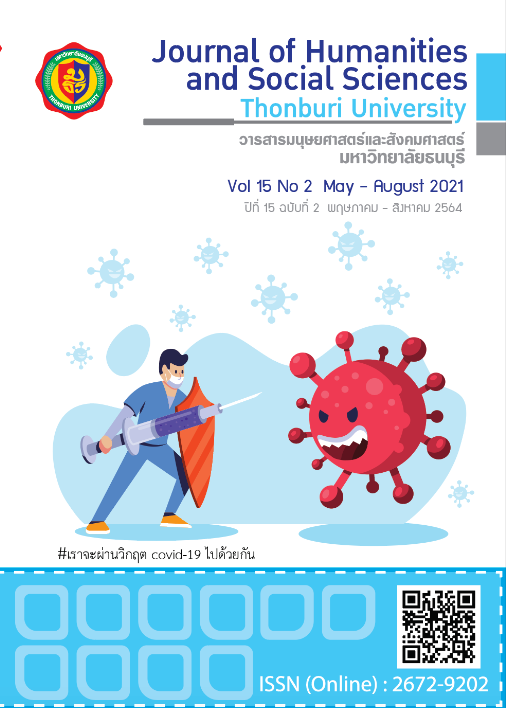Guidelines for Tourism Development in the World Heritage City and the World Creative City by the Sukhothai Old Town Community in the New Normal Course after the COVID-19 Situation
Keywords:
Tourism Development, World Heritage City, World Creative City, New Normal, COVID-19 SituationAbstract
This article aimed to determine tourism potentials and create developmental guidelines in the world heritage city and the world creative city by the Sukhothai Old Town community in the new normal course after the COVID-19 situation. The qualitative approach was used to collect primary and secondary data using in-depth interview from purposively selected 18 key informants using semi-structured interview, snowball sampling, and participant observation, and the quantitative approach was used to collect data using a questionnaire from accidentally selected 400 key informants, and percentage and average were used for data analysis. Determination of tourism potentials was conducted using a focus group and data triangulation among government and non-government representatives and community leaders, and it was suggested to have 1) package tour improvement based on tourist behaviors and special interests, 2) continuous marketing communication to meet tourist needs, 3) tourist centers providing prerequisite information, 4) readiness preparation on service standards, languages, and tourism management, 5) product identity of Sukhothai Old Town, and 6) attraction’s notice sign improvement.
References
กรมการท่องเที่ยว. (2562). สถิตินักท่องเที่ยว. สืบค้นเมื่อ 14 มีนาคม 2562, จาก https://www.mots.go.th/Emphandhu
กรุงเทพธุรกิจ. (2562). รวม 5 แหล่งมรดกโลกในไทยที่ควรค่าแก่การอนุรักษ์. สืบค้นเมื่อ 14 มีนาคม 2562, จาก http://www.bangkokbiznews.com/recommended/d
กัลยา วานิชย์บัญชา. (2549) สถิติสำหรับงานวิจัย. พิมพ์ครั้งที่ 2. กรุงเทพฯ: โรงพิมพ์จุฬาลงกรณ์มหาวิทยาลัย.
ฐานเศรษฐกิจ. (2563). “สุโขทัย”คว้าเครือข่ายเมืองสร้างสรรค์ยูเนสโก้. สืบค้นเมื่อ 30 มิถุนายน 2563, จาก https://www. thansettakij.com/content/strategy/418131
ดรรชนี เอมพันธุ์. (2550). การพัฒนาการท่องเที่ยวโดยชุมชนและการจัดกิจกรรมโฮมสเตย์. กรุงเทพฯ: สำนักพิมพ์มหาวิทยาลัย เกษตรศาสตร์.
เทิดชาย ช่วยบำรุง. (2552). บทบาทขององค์กรปกครองส่วนท้องถิ่นกับการพัฒนาการท่องเที่ยวอย่างยั่งยืนบนฐานแนวคิดเศรษฐกิจพอเพียง. กรุงเทพฯ: สำนักพิมพ์คณะรัฐมนตรีและราชกิจจานุเบกษา.
ธนาคารแห่งประเทศไทย. (2563). ผลกระทบวิกฤต COVID-19 กับเศรษฐกิจโลก: This Time is Different. สืบค้นเมื่อ 29 มิถุนายน 2563, จาก https://www.bot.or.th/Thai/ResearchAndPublications/articles/-Pages/Article_ 18Mar 2020.aspx
บุญเลิศ จิตตั้งวัฒนา. (2548). การวางแผนพัฒนาการท่องเที่ยวแบบยั่งยืน. เชียงใหม่: คณะมนุษยศาสตร์ สำนักพิมพ์มหาวิทยาลัยเชียงใหม่.
พจนา สวนศรีและสมภพ ยี่จอหอ. (2556). คู่มือมาตรฐานการท่องเที่ยวโดยชุมชน. เชียงใหม่: วนิดาการพิมพ์.
วรรณวิมล ภู่นาค. (2558). ศักยภาพชุมชนในการจัดการท่องเที่ยวโดยชุมชน: กรณีศึกษาตลาดน้ำอัมพวา. วารสารวิทยบริการ มหาวิทยาลัยสงขลานครินทร์. 26(1): 72.
ศิริเพ็ญ ดาบเพชร. (2561). องค์ประกอบการท่องเที่ยวและช่องทางการสื่อสารภาพลักษณ์การท่องเที่ยวสำหรับกลุ่มนักท่องเที่ยวอนาคต กรณีศึกษาจังหวัดพิษณุโลก. วารสารการวิจัยเพื่อพัฒนาชุมชน (มนุษยศาสตร์และสังคมศาสตร์). 11(1): 79-98.
ศูนย์วิจัยกสิกรไทย. (2563). COVID-19 ฉุดการท่องเที่ยวโลกหยุดชะงัก คาด…ทั้งปีหดตัว 38-45%. สืบค้นเมื่อ 29 มิถุนายน 2563, จาก https://kasikornresearch.com/th/analysis/k-social-media/Pages/COVID-19-World-Tourism.aspx
Becker, G. S. (1962). Investment in human capital: A theoretical analysis. Journal of political economy, 70 (5, Part 2): 9-49.
Dickman, S. (1996). Tourism: An Introductory Text. (2nd ed). Sydney: Hodder Education.
Dwyer, L., & Kim, C. (2003). Destination competitiveness: Determinants and indicators. Current Issues in Tourism, 6(5): 369-414.
Loureiro, S. M. C., & Gonzalex, F. J. M. (2008). The importance of quality, satisfaction, trust, and image in relation to rural tourism loyalty. Journal of Travel & Tourism Marketing. 25(2): 117-136.
Marcouiller, D. W. (1998). Environment resources as latent primary factors of production in tourism: the case of forest-based commercial recreation. Tourism Economics, 4(2): 131-145.
Schofield, P. (2002). Developing a day trip expectation/satisfaction construct: a comparative analysis of scale construction techniques. Journal of Travel & Tourism Marketing. 8(3): 101-109.
Shimp, T.A. (2000). Advertising, promotion, and supplemental aspects of integrated marketing communication. 5th ed., Fort Worth, TX: Dryden Pres.
Xiang, Z., & Gretzel, U. (2010). Role of social media in online travel information search. Tourism Management, 31(2):179-188.
Yoon, Y., & Uysal, M. (2005). An examination of the effects of motivation and satisfaction on destination loyalty: a structural model. Tourism management, 26(1): 45-56.
Yoo, K. H., Lee, K. S., & Gretzel, U. (2007), The role of Sourch Characteristics in Ewom: What makes Online Travel Reviewers Credible and Likeable?, In Information and Communication Technologies in Tourism 2007, edited by M. Sigala, L. Mich, J. Murphy and A. Frew. Edinburgh: Axon Imprint: 23-34.
Translated Thai References
Bangkokbiznews. (2019). A collection of 5 world heritage sites in Thailand that are worth conservation. Retrieved March 14, 2019, from http://www.bangkokbiznews.com/recommended/d. (in Thai)
Bank of Thailand. (2020). The impact of the COVID-19 crisis on the global economy: This Time is Different. Retrieved June 29, 2020, from https://www.bot.or.th/Thai/ResearchAndPublications-/articles/Pages/ Article_18Mar2020.aspx. (in Thai)
Choibamroong, Therdchai. (2009). The role of local government organizations and sustainable tourism development based on the sufficiency economy concept. Bangkok: Cabinet and Royal Gazette Publishing Office. (in Thai)
Dabphet, Siripen . (2018). Tourism Attributes and Communication Channels of Tourism Image for Future Tourists: The Case of Phitsanulok. Journal of Community Development Research (Humanities and Social Sciences). 11(1): 79-98. (in Thai)
Dachanee. (2007). Community–Based Tourism development and homestay activities. Bangkok: Kasetsart University Press. (in Thai)
Department of Tourism. (2019). Tourists’Statistics. Retrieved March 14, 2019, from https://www.mots.go.th (in Thai)
Jittungwattana, Boonlert. (2005). Sustainable Tourism Development Planning. Chiang Mai. Faculty of Humanities, Chiang Mai University Press. (in Thai).
Kasikornthai Research Center. (2563). COVID-19 Traces the World Tourism Disruption Expected contract year by 38-45%. Retrieved June 29, 2020, from https://kasikornresearch.com/th/-analysis/k-social-media/ Pages/COVID-19-World-Tourism.aspx (in Thai)
Poonak, Wanwimol. (2015). The Potentials of Amphawa Community in Managing Community-Based Tourism of the Amphawa Floating Market. Academic Service Journal Prince of Songkha University. 26(1): 72. (in Thai)
Suansri, Potjana., & Yeejawhaw, Somphop. (2013). Community standard tourism guide. Chiangmai: Wanida Printing. (in Thai)
Thansettakij. (2563). "Sukhothai" seized the network of creative cities UNESCO. Retrieved June 30, 2020, from https://www.thansettakij.com/content/strategy/418131 (in Thai)
Vanichbuncha, Kanlaya. (2006). Statistical Analysis for Research. 2th ed. Bangkok: Chulalongkorn University Printing Hourse. (in Thai)







